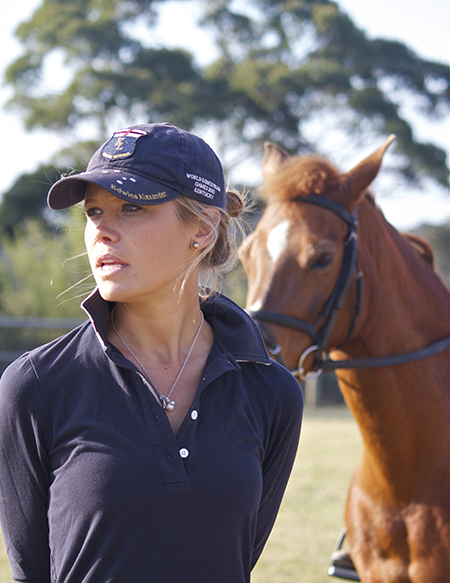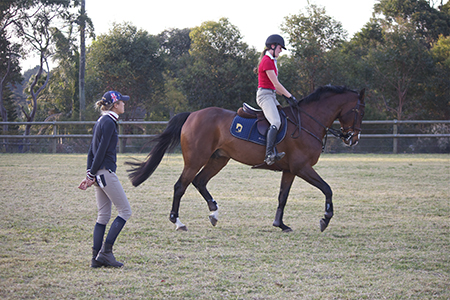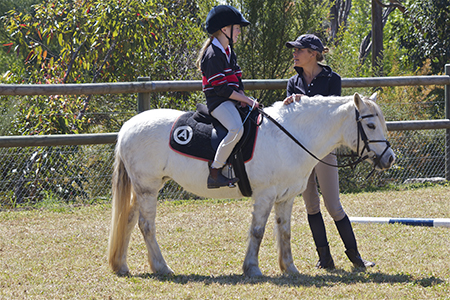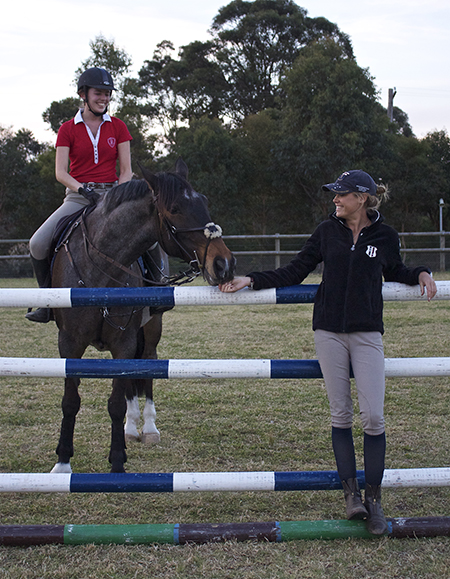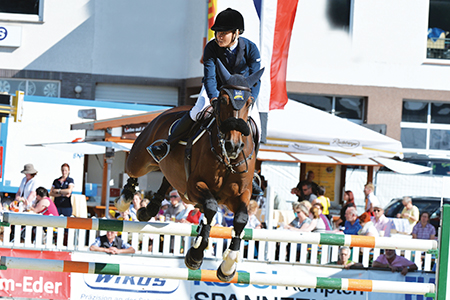Rebecca Ashton sits in on a lesson with Julia Hargreaves – From Olympic Games to grassroots…
Julia Hargreaves is just back from London where she exceeded all her expectations and made the individual showjumping final at her very first Olympics. Not one to rest on her laurels, she’s out on a crisp Sydney morning helping the next generation of showjumpers at Arcadia Pony Club and afterwards taking a lesson with young rider and regular student Georgie Harvey.
Some athletes talk about giving back to the sport; 26-year-old Julia is actually out there doing it. Like all good trainers, she focuses on the basics: “Straight lines and eyes up”, is the mantra for the day. “Straightness is my thing,” Julia concedes. She gives each rider so much time individually that she has to forgo most of her lunch break. She won’t move onto the next rider until she is 100% happy with the work of the previous child.
Julia starts the riders with flat work: “I like to focus on the flat work separately,” she explains. She hones in on stirrup length and rider position. “Sit up taller, be light on his back,” she encourages, “try not to hang on his mouth. Be soft so he can be soft also”.
She wants each rider to go through the “checklist” she gives them before every transition, to take their time and think everything through.
Once she is satisfied with this, it is time to move onto pole work. Julia has set up four poles that lie on a square track to work on straightness and correct turns. “It is very, very important to be straight before and after the jump,” she insists. “Keep the horse straight even though you are looking into the next turn. Sooner or later you have to become comfortable with not looking at your horse, but feeling it. Treat the trot poles as if they’re not there and let the horse worry about that. It’s his decision and his job to find the distance to the poles.” She would like the horses to think for themselves. The exercise is simple but builds confidence in both horse and rider.
Julia then looks at canter control. When a horse slows or wants to go back to the group of waiting riders, “Ride, ride! Use your leg! Don’t stop!” she insists, not letting up for a second and expecting the rider to follow suit. “The horse has to go exactly where you want him to.”
The riders are then asked to ride a whole course. There are white cones set about at different points to help the riders find their lines and ride straight to the jumps. “The cones are more important to me than the actual jumps,” Julia tells her students. She is also quick to point out, “Go around the cones – and I don’t mean sporting turns! Nice big, soft turns are what I’m after.”
When one rider gets rattled by the dazzle board, Julia helps out, “If there is a fence on the course you’re worried about, jump it and then forget it. Don’t hassle him about the jumps afterwards.”
Another rider, when her horse hesitates at a jump, bellows encouragement at the top of her lungs, rather shocking Julia who quietly suggests, “Using your voice is good. Using your body is better. He has to take you to the jump. Keep it active. You’re hunching over so you have no seat. Stay tall with the body so you can ride him to the fence and so you don’t fall off if he refuses”.
Then there’s the other extreme with a pony that looks more used to sporting. “Stop being in such a hurry. You have time,” she instructs.
Julia makes the rider take the course again, asking the combination to stop whenever she yells out. Soon the horse is back under control, but still sometimes landing on the wrong canter lead. “You have to correct it on the straight line. Do it through the trot. I don’t want to see any flying changes”
Julia then explains one of her favourite jumping exercises: “I like to set up a normal seven stride line, vertical to an oxer, which can be jumped in both directions. I have the horse and rider do the line repetitively but changing the amount of strides they do each time. I tell them how many strides to do, so they have to change their canter and their approach. It helps to teach the rider how to judge a distance, and also to react quickly when they jump into a line on course. It also allows them to work on their position as once they get comfortable with the exercise they can then think more about what they are doing over the fence.”
Later in the afternoon, Georgie Harvey is ready to go through her paces. She has brought two horses, a ten-year-old imported Belgium Warmblood, Tresor and Blue Rinse, imported last year from New Zealand with the help of George Sanna.
Based at the Hargreaves’ Copabella Stud, 19-year-old Georgie started training with Julia when she was 14. She began by going to jumping shows with Julia and dressage shows with Julia’s Mum, Lesley. Julia won out in the end with the pair going to jumping events almost every weekend.
Georgie explains: “We work very well together and she knows how to get me to work really, really hard. Even though Julia is based overseas I send her videos of almost every round I do at shows straight after each round and she will give me feedback as soon as possible so I’ll know what I’ve got to work on the next day of competition. It’s great how dedicated she is and I really appreciate how much effort she puts into training me.”
Georgie will soon be joining Julia in Europe, heading over to do a few indoor shows with the young horse Copabella Vegas before coming back home to do the last couple of shows of the year in Australia. Early next year Tresor and Blue will be heading over to Europe with Julia and then Georgie will move over in April/May to start competing them.
As Julia adjusts the jumps, she has Georgie work on Tresor’s canter. She wants the horse adjustable and listening to its rider. “Move him forward and back within the stride.”
“With Georgie, it is fine tuning; making sure everything is in order,” Julia tells me.
The first jump is an inviting cross rail, which is gradually taken higher. “Once more,” Julia asks, “because when you keep him straight, he just changes. Inside leg; sit up. Excellent”.
Georgie then tries Tresor over an oxer. “When you want to fix it, don’t stand up,” Julia encourages, making small adjustments to Georgie’s riding before they have a go at a whole course. The focus once again is on lines and straightness and afterwards a little canter work on a circle to get him a bit softer.
Blue Rinse is next out and is feeling pretty good about himself: “Let him go forward a bit in a forward seat to get him a little bit tired” Julia suggests. Still recovering from a bout of glandular fever, Georgie is doing her best and finally the big, solid horse is with her. Before they try the course, Julia explains, “Don’t throw yourself at the fences especially when he’s hot and flat”.
Georgie jumps clear but is aware that there are a couple she could have jumped better. She comments on each one as soon as she lands but has a smile on her face the whole time.
She loves her jumping and she obviously loves working with her encouraging and supportive young coach who remains lighthearted but still able to get her message across. Georgie’s future is in safe hands with Julia and both girls have a big future ahead of them.
Julia and Vedor jumping at the WEG Qualifier in Spangenburg earlier this year
Interview with Julia
Tell us a bit about Vedor…
“He knows he’s pretty good but he’s not arrogant. He’s just very particular as to who his friends are. He’s not at all a horse that needs other horses around. He gets pretty chummy with the one person, normally the groom. He is a definite ADD kid; 100%, but that is partly what makes him as good as he is because in the warm-up, for instance, he’ll faff a bit, carry on and do annoying things to encourage you to react but you have to ignore him and then he gets bored and drops it. But the thing is, no matter what happens in the warm-up, the moment he goes into the arena, he becomes the most professional horse I have ever ridden; so concentrated and so on the job.”
Who has been your biggest influence?
“Definitely my Mum. And I’ve had a lot of coaches throughout my career who have played a huge part, especially Lucie McKinney in America, Robyn Cameron my coach at NEGS, George Sanna, Edwina Alexander and Denis Lynch.”
How much teaching do you do?
“Obviously there’s been more interest in clinics since I did that thing in London. I’m more into and really love managing a rider. I’ve done that with Georgie for quite a while now and I really enjoy it. She is just a natural talent and personality-wise we really get on. If she’s out competing and I’m not there, I hate it. I really want to be there and see her go well.”
“I also used to manage Susie Willis when I was here and she’s another one of those kids that I really get a lot of enjoyment out of helping. But I don’t do it on a large scale. I prefer to have just a few students that I manage completely and that I’m close to.”


